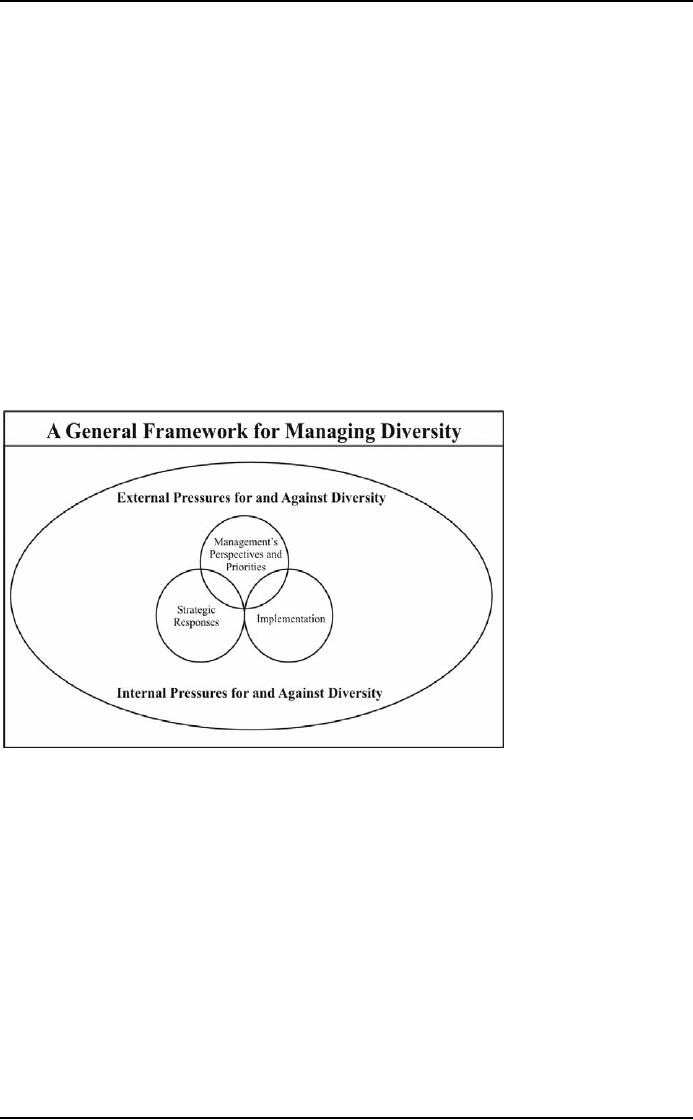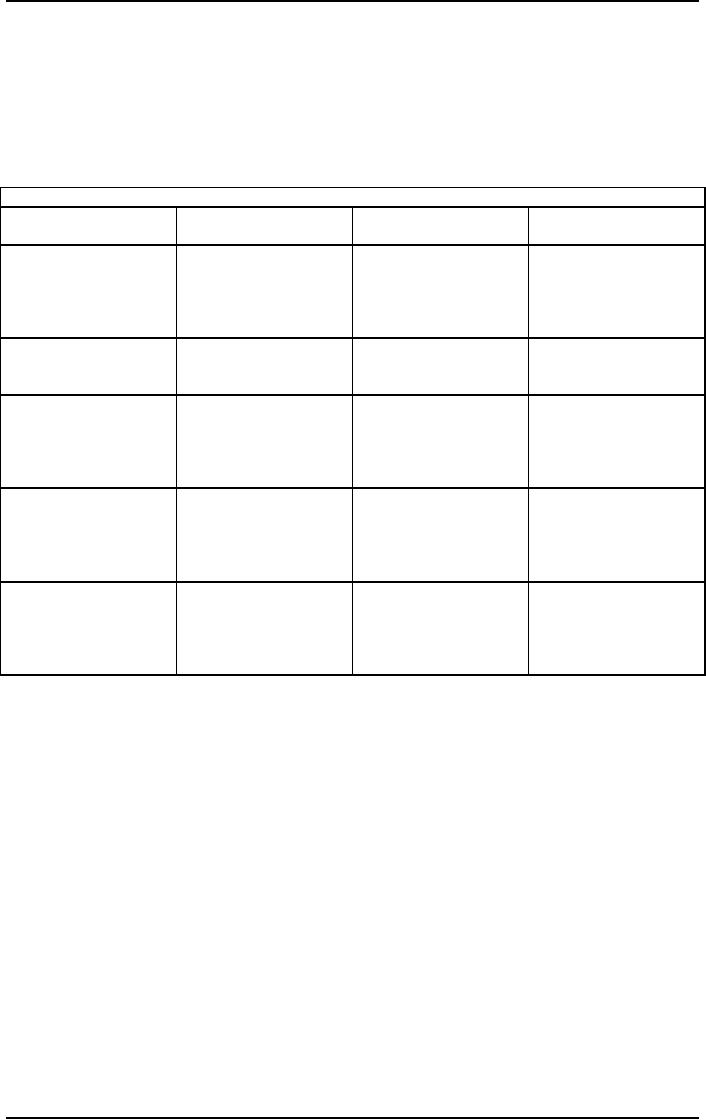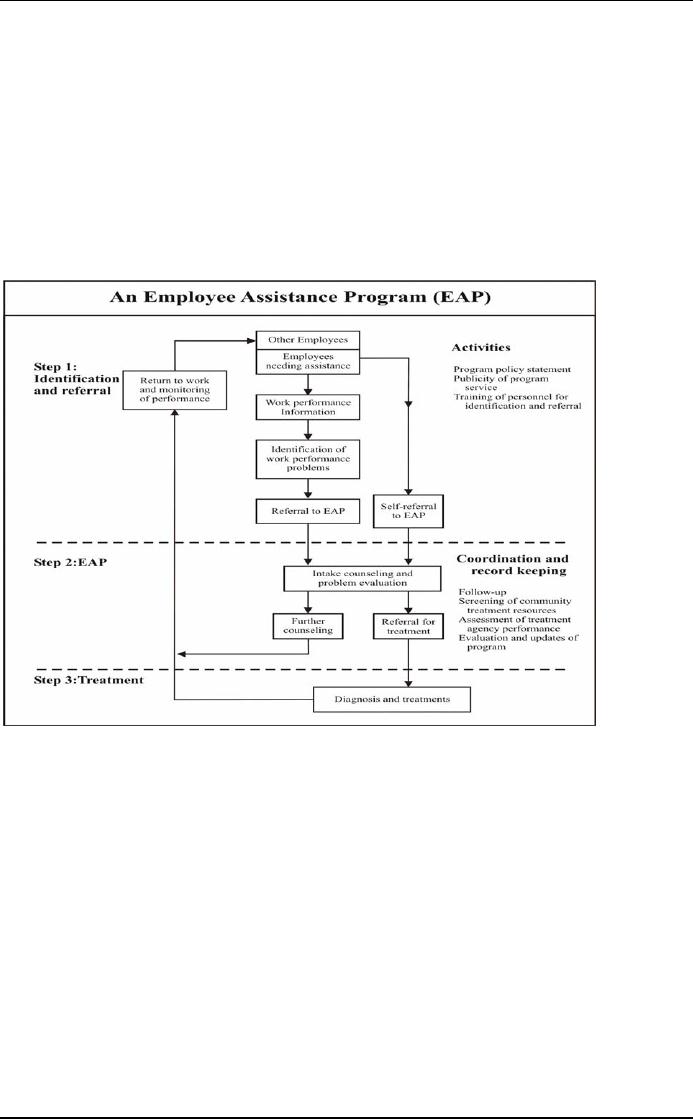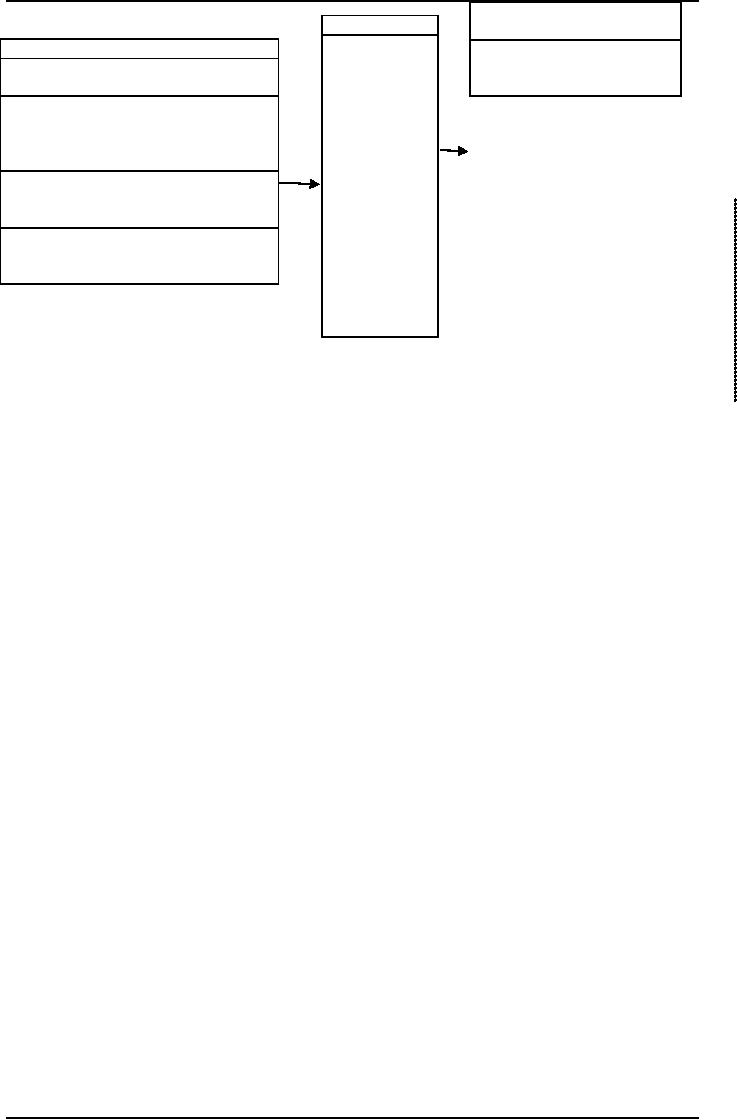 |

Organization
Development MGMT
628
VU
Lesson
# 41
Developing
and Assisting Members
Workforce
Diversity Interventions
Several
profound trends are shaping
the labor markets of modern
organizations. Researchers suggest
that
contemporary
workforce characteristics are
radically different from what they
were just twenty years
ago.
Employees
represent every ethnic background and
color; range from highly
educated to illiterate; vary in
age
from eighteen, to eighty; may
appear perfectly healthy or may have a
terminal illness; may be
single
parents
or part of dual-income, divorced,
same-sex, or traditional families;
and may be physically
or
mentally
challenged.
Workforce
diversity is more than a euphemism for
cultural or ethnic differences. Such a
definition is too
narrow
and focuses attention away
from the broad range of issues
that a diverse workforce
poses. Diversity
results
from people who bring
different resources and
perspectives to the workplace and who
have distinc-
tive
needs, preferences, expectations,
and lifestyles.42 Organizations must design
human resources
systems
that
account for these
differences if they are to attract
and retain a productive workforce
and if they want
to
turn diversity into a competitive
advantage.
Figure
55 presents a general framework for
managing diversity in
organizations.
Figure
55
First,
the model suggests that an organization's
diversity approach is a function of
internal and external
pressures
for and against diversity.
Pro-diversity forces argue that
organization performance is
enhanced
when
the workforce's diversity is embraced as an
opportunity. But diversity is often
discouraged by those
who
fear that too many
perspectives, beliefs, values,
and attitudes dilute
concerted action.
Second,
management's perspective and
priorities with respect to diversity
can range from resistance
to
active
learning and from marginal to
strategic. For example,
organizations can resist diversity
by
implementing
only legally mandated
policies such as affirmative action,
equal employment opportunity, or
Americans
with Disabilities Act requirements. On
the other hand, a learning and
strategic perspective
can
lead
management to view diversity as a source
of competitive advantage. For
example, a health-care
organization
with a diverse customer base
can improve perceptions of
service quality with
physician
diversity.
Third,
within management's priorities, the
organization's strategic responses
can range from reactive
to
proactive.
Diversity efforts at Texaco
and Denny's had little
momentum until a series of embarrassing
race-
based
events forced a response.

Organization
Development MGMT
628
VU
Fourth,
the organization's implementation style
can range from episodic to
systemic. A diversity approach
will
be most effective when the strategic
responses and implementation
style fit with management's
intent
and
internal and external
pressures.
Unfortunately,
organizations have tended to
address workforce diversity pressures in
a piecemeal fashion;
only
5 percent of more than fourteen
hundred companies surveyed
thought they were doing a
"very good
job"
of managing diversity. As each
trend makes itself felt, the organization
influences appropriate practices
and
activities. For example, as the
percentage of women in the workforce
increased, many
organizations
simply
added maternity leaves to their benefits
packages; as the number of physically
challenged workers
increased
and when Congress passed the
Americans with Disabilities Act in
1990, organizations
changed
their
physical settings to accommodate
wheelchairs. Demographers warn, however,
that these trends
are
not
only powerful by themselves
but will likely interact
with each other to force organizational
change.
Thus,
a growing number of organizations, such
as MBNA Corporation, Lockheed Martin, the
St. Paul
Companies,
Levi Strauss, Procter & Gamble,
Monsanto, and Wisconsin Electric,
are taking bolder
steps.
They
are not only adopting
learning perspectives with respect to
diversity, but systemically
weaving
diversity-friendly
values and practices into
the cultural fabric of the organization.
Many
of the QD interventions described in this
book can be applied to the strategic
responses and
implementation
of workforce diversity, as shown in
Table 21. It summarizes
several of the internal
and
external
pressures facing organizations,
including age, gender,
disability, culture and values,
and sexual
orientation.
The table also reports the major trends
characterizing those dimensions,
organizational
implications
and workforce needs, and
specific OD interventions that
can address those
implications.
Age
The
average age of the U.S.
workforce is rising and changing the
distribution of age groups.
Between 1998
and
2008, the category of workers
aged twenty-five to fifty-four
years will grow 5.5
percent and the
fifty-
five
and over age category is
expected to increase almost 48
percent. This skewed
distribution is mostly the
result
of the baby boom between
1946 and 1964. As a result,
organizations will face a
predominantly
middle-aged
and older workforce. Even
now, many organizations are
reporting that the average
age of their
workforce
is over forty. Such a
distribution will place
special demands on the
organization.
For
example, the personal needs
and work motivation of the
different cohorts will require
differentiated
human
resources practices. Older
workers place heavy demands
on health-care services, are
less mobile,
and
will have fewer career
advancement opportunities. This
situation will require specialized
work designs
that
account for physical
capabilities of older workers,
career development activities that
address and use
their
experience, and benefit
plans that accommodate their
medical and psychological
needs. Demand for
younger
workers, on the other hand,
will be intense. To attract
and retain this more mobile group,
jobs will
have
to be more challenging, advancement
opportunities more prevalent, and an
enriched quality of
work
life
more common.
Organization
development interventions, such as work
design, wellness programs
(discussed below), career
planning
and development, and reward
systems must be adapted to
these different age groups.
For the
older
employee, work designs can
reduce the physical components or
increase the knowledge and experi-
ence
components of a job. At Builder's
Emporium, a chain of home
improvement centers, the store
clerk
job
was redesigned to eliminate heavy
lifting by assigning night
crews to replenish shelves
and emphasizing
sales
ability instead of strength.
Younger workers will
likely

Organization
Development MGMT
628
VU
Table
21
Workforce
Diversity Dimensions and Intervention
Work
force
Trends
Implications
Interventions
Difference
And
Needs
Age
Median
age
up
Health care
mobility
Wellness program job
distribution
of ages security
design
changes
Career
planning and
development
reward
system
Gender
Percentage
of women
Child
Care
Job
design
increases
Dual income
Maternity/paternity
Fringe
benefits Rewards
families
leave
single parents
Disability
The
number of people
Job
challenge
Performance
with
disabilities entering
Job
skills
management
the
workforce increasing
Physical
space
Job
design
Respect
and dignity
Career
planning and
development
Culture
and Values
Rising
proportion of
Flexible
organizational Career planning
and
immigrant
and minority
policies
development
group
workers shift in
Autonomy
Employee
involvement
Reward
system
rewards
Affirmation
Respect
Sexual
orientation
Number
of single sex
Discrimination
Equal
employment
households
up
Opportunities
More
liberal Attitude
Fringe
benefits
towards
sexual
Education
and training
orientation
Require
more challenge and autonomy.
Wellness programs can be
used to address the physical
and mental
health
of both generations. Career
planning and development programs
will have to recognize the
different
career
stages of each cohort and
offer resources tailored to
that stage. Finally, reward
system interventions
may
offer increased health benefits, time
off, and other perks
for the older worker while
using promotion,
ownership,
and pay to attract and
motivate the scarcer, younger
workforce.
Gender
Another
important trend is the increasing
percentage of female workers in the
labor force. By the year
2008,
almost 48 percent of the U.S.
workforce will be women, and
they will represent more
than half of the
new
entrants between 1998 and
2008. The organizational implications of
these trends are sobering.
Three-
quarters
of all working women are in
their childbearing years, and
more than half of all
mothers work.
Health-care
costs will likely increase
at even faster rates, and
costs associated with
absenteeism and
turnover
will rise. In addition,
demands for child care,
maternity and paternity leaves,
and flexible working
arrangements
will place pressure on work
systems to maintain productivity and
teamwork. From a
management
perspective, there will be
more men and women
working together as peers, more
women
entering
the executive ranks, greater diversity of
management styles, and
changing definitions of
managerial
success.
Work
design, reward systems, and
career development are among the
more important interventions
for
addressing
issues arising out of the
gender trend. For example,
jobs can be modified to
accommodate the
special
demands of working mothers. A number of
organizations, such as Digital
Equipment, Steel
case,
and
Hewlett-Packard, have instituted job
sharing, by which two people
perform the tasks associated
with
one
job. The firms have done this to
allow their female employees
to pursue both family and
work careers.

Organization
Development MGMT
628
VU
Reward
system interventions, especially
fringe benefits, can be tailored to
offer special leaves to
mothers
and
fathers, child-care options,
flexible working hours, and
health and wellness benefits.
Career
development
interventions help maintain, develop, and
retain a competent and diverse
workforce.
Organizations
such as Polaroid, Hoechst Celanese, and
Ameritech have instituted
job pathing, challenging
assignments,
and mentoring programs to retain
key female members.
Disability
A
third trend is the increasing number of
men and women with
disabilities entering the workforce.
The
workforce
of the twenty-first century will
comprise people with a variety of
physical and mental
disabilities.
For
example, the high school
dropout rate has remained
above 4 percent throughout the
1990s, and
approximately
21 percent of the population over
age 16 have only rudimentary
reading and writing skills.
In
a
world of knowledge work, the lack of
education or an inability to learn is a
profoundly debilitating
condition.
More and more organizations
will employ physically handicapped
people, especially as the
number
of younger workers declines, creating a
great demand for labor. In
1990, the federal
Americans
with
Disabilities Act banned all forms of
discrimination on the basis of physical or
mental disability in the
hiring
and promotion process. It
also required many organizations to
modify physical plants and
office
buildings
to accommodate people with
disabilities.
The
organizational implications of the disability trend
represent both opportunity
and adjustment. The
productivity
of physically and mentally disabled
workers often surprises
managers, and training is
required
to
increase managers' awareness of this
opportunity. Employing disabled
workers, however, also means
a
need
for more comprehensive health
care, new physical workplace
layouts, new attitudes
toward working
with
the disabled and challenging
jobs that use a variety of
skills.
OD
interventions, including work
design, career planning and
development, and performance
management,
can be used to integrate the
disabled into the workforce.
For example, traditional
approaches
to
job design can simplify
work to permit physically
handicapped workers to complete an
assembly task.
Career
planning and development programs
need to focus on making disabled
workers aware of
career
opportunities.
Too often, these employees
do not know that advancement
is possible, and they are
left
feeling
frustrated. Career tracks need to be
developed for these
workers.
Performance
management interventions, including
goal setting, monitoring,
and coaching
performance,
aligned
with the workforce's characteristics are
important. At Blue Cross and Blue
Shield of Florida,
for
example,
a supervisor learned sign
language to communicate with a
deaf employee whose
productivity was
low
but whose quality of work
was high. Two other
deaf employees were
transferred to that
supervisor's
department,
and over a two-year period, the
performance of the deaf workers
improved 1,000 percent
with
no
loss in quality.
Culture
and Values
Cultural
diversity has broad organizational implications.
Different cultures represent a variety of
values,
work
ethics, and norms of correct
behavior. Not all cultures
want the same things from work,
and simple,
piecemeal
changes in specific organizational
practices will be inadequate if the
workforce is culturally
diverse.
Management practices will
have to be aligned with cultural
values and support both
career and
family
orientations. English is a second language
for many people, and jobs of
all types
(processing,
customer
contact, production, and so
on) will have to be adjusted
accordingly. Finally, the organization
will
be
expected to satisfy both extrinsic
and monetary needs, as well
as intrinsic and personal
growth needs.
Several
planned change interventions, including
employee involvement, reward
systems, and career
planning
and development, can be used to
adapt to cultural diversity. Employee
involvement practices
can
be
adapted to the needs for
participation in decision making.
People from certain
cultures, such as
Scandinavia,
are more likely to expect
and respond to high-involvement
policies; other cultures,
such as
Latin
America, view participation
with reservation. Participation in an
organization can take many
forms,
from
suggestion systems and
attitude surveys to high-involvement
work designs and
performance
management
systems. Organizations can maximize
worker productivity by basing the amount
of power and
information
workers have on cultural and
value orientations.
Reward
systems can focus on
increasing flexibility. For
example, flexible working
hours that permit
employees
to arrive at and leave work
within specified periods
enable them to meet personal
obligations
without
sacrificing organizational objectives.
Many organizations have implemented this
innovation, and
most
report that the positive benefits
outweigh the costs. Work locations
also can be varied.
Many
organizations
(e.g., Pacific Telesis,
Eddie Bauer, and Marriott)
allow workers to spend part
of their time
telecommuting
from home. Other flexible
benefits, such as floating
holidays, allow people from
different
cultures
to match important religious and
family occasions with work
schedules.
Child-care
and dependent-care assistance
also support different
lifestyles. For example, at
Stride Rite
Corporation,
the Stride Rite Intergenerational Day
Care Center houses
fifty-five children between the
ages

Organization
Development MGMT
628
VU
of
fifteen months and six years
as well as twenty-four elders
over sixty years old. The
center was
established
after
an organizational survey determined that 25
percent of employees provided
some sort of elder
care
and
that an additional 13 percent anticipated
doing so within five
years.
Finally,
career planning and development
programs can help workers
identify advancement
opportunities
that
are in line with their
cultural values. Some cultures
value technical skills over
hierarchical advancement;
others
see promotion as a prime indicator of
self-worth and accomplishment. By
matching programs
with
people,
job satisfaction, productivity,
and employee retention can
be improved.
Sexual
Orientation
Finally,
diversity in sexual and affectional
orientation, including gay,
lesbian, and bisexual
individuals and
couples,
increasingly is affecting the way that
organizations think about
human resources.
The
primary organizational implication of sexual
orientation diversity is discrimination. People
can have
strong
emotional reactions to sexual
orientation. When these
feelings interact with the gender,
culture, and
values
trends described above, the
likelihood of both overt and
unconscious discrimination is
high.
Interventions
aimed at this dimension of workforce diversity
are relatively new in OD and
are being
developed
as organizations encounter sexual
orientation issues in the workplace.
The most frequent
response
is education and training. This
intervention increases members'
awareness of the facts
and
decreases
the likelihood of overt discrimination.
Human resources practices having to do
with Equal
Employment
Opportunity (EEO) and fringe
benefits also can help to
address sexual orientation
parity
issues.
Some organizations have
modified their EEO
statements to address sexual
orientation. Firms
such
as
Advanced Micro Devices, Fujitsu, Ben
& Jerry's, and Dow
Chemical have communicated strongly
to
members
and outsiders that decisions
with respect to hiring,
promotion, transfer, and so on cannot
(and
will
not) be made with respect to
a person's sexual orientation. Similarly,
organizations are
increasingly
offering
domestic-partner benefit plans.
Companies such as Microsoft,
Apple, Lotus
Development
Corporation,
and Inprise Borland have
extended health-care and
other benefits to the same-sex partners
of
their
members. A 1992 Newsweek
poll found that 78 percent
of the respondents favored
extending
employee
benefits to the domestic partners of
lesbians and gay
men.
Workforce
diversity interventions are growing
rapidly in OD. A national
survey revealed that 75
percent of
firms
either have, or plan to begin, diversity
efforts. Research suggests
that diversity interventions
are
especially
prevalent in large organizations with
diversity-friendly senior management
and human resources
policies.
Although existing evidence shows
that diversity interventions are
growing in popularity, there
is
still
ambiguity about the depth of organizational commitment
to such practices and their
personal and
organizational
consequences. A great deal
more research is needed to
understand these newer
interventions
and
their outcomes.
Employee
Wellness Interventions
In
the past decade, organizations
have become increasingly
aware of the relationship between
employee
wellness
and productivity. The
estimated cost to industry from
stress-related ailments is more
than $200
billion
per year and is an
increasingly global phenomenon. In the United
Kingdom, stress and
stress-related
illness
cost industry and taxpayers
�12 billion each year.
Employee
assistance programs (EAPs)
and
stress
management interventions have
grown because organizations
are taking more responsibility
for the
welfare
of their employees. Companies
such as Johnson & Johnson,
Weyerhaeuser, Federal
Express,
Quaker
Oats, GTE, and Abbott
Laboratories are sponsoring a wide range
of fitness and wellness
programs.
In
this section, we discuss two
important wellness interventions--EAPs
and stress management. EAPs
are
primarily
reactive efforts that
identify, refer, and treat
employee problems (e.g., drug
abuse, marital
difficulties,
or depression) that affect worker
performance. Stress management,
both proactive and
reactive,
is
concerned with helping
employees alleviate or cope
with the negative consequences of
stress at work.
Employee
Assistance Programs
Forces
affecting psychological and physical
problems at the workplace are increasing.
The 1992 National
Household
Survey on Drug Abuse reported
that 66.5 percent of current
illicit drug users then 18
years or
older
were working full- or part-time.
Similarly, alcohol and other drug
use costs U.S. business an
estimated
$102
billion per year in lost
productivity, accidents, and
turnover. Britain's Royal College of
Psychiatrists
suggested
that up to 30 percent of employees in
British companies would
experience mental health
problems
and that 115 million
workdays were lost each year
as a result of depression. Other
factors, too,
have
contributed to increased problems:
altered family structures, the
growth of single-parent
households,
the
increase in divorce, greater mobility,
and changing modes of child
rearing are all fairly
recent
phenomena
that have added to the
stress experienced by employees.
These trends indicate that
an
increasing
number of employees need assistance
with personal problems, and
the research suggests
that
EAP
use increases during downsizing
and restructuring.

Organization
Development MGMT
628
VU
EAPs
help identify, refer, and
treat workers whose personal
problems affect their performance.
Initially
started
in the 1940s to combat alcoholism,
these programs have expanded
to deal with emotional,
family,
marital,
and financial problems, and,
more recently, drug abuse. EAPs
can be either broad programs
that
address
a full range of issues or
more focused programs
dealing with specific
problems, such as drug or
alcohol
abuse.
Central
to the philosophy underlying EAPs is the
belief that although the organization
has no right to
interfere
in the private lives of its
employees, it does have a
right to impose certain
standards of work
performance
and to establish sanctions
when these are not
met. Anyone whose work
performance is
impaired
because of a personal problem is eligible
for admission into an EAP
program. Successful EAPs
have
been implemented at General Motors,
Johnson & Johnson, Motorola,
Burlington Northern
Railroad,
and
Dominion Foundries and Steel Company.
Although limited, some
research has demonstrated
that
EAPs
can positively affect
Figure
56
Absenteeism,
turnover, and job
performance. At AT&T, for example,
fifty-nine employees who
were close
to
losing their jobs were
enrolled in an EAP and
successfully returned to work. Hiring
and training
replacements
would have been much
more costly than the expense of the
EAP.
The
Employee Assistance Program
Model
Figure
56 displays the components of a typical
EAP. They include the identification and
referral of
employees
into the program, management of the EAP
process, and problem
diagnosis and treatment.
1.
Identification and referral. The
first step in an EAP is
entry into the program,
through formal or
informal
referral. In the case of formal
referrals, the process involves
identifying employees who
are having
work
performance problems and getting them to
consider entering the EAP. Identifying
these employees is
closely
related to the performance management
process. Performance records
need to be maintained and
corrective
action taken whenever performance
falls below an acceptable
standard. During action
planning
to
improve performance, managers
can point out to appraisers
the existence of support services,
such as
the
EAR. A formal referral takes
place if the performance of an employee
continues to deteriorate and the
manager
decides that EAP services
are required. An informal referral occurs
when an employee initiates
admission
to an EAP even though
performance problems may not
exist or may not have
been detected.
As
shown in Figure 56, several
organizational activities support this initial
step in the EAP process. First,
a
written
policy with clear procedures
regarding the EAP is necessary.
Second, top management and
the
human
resources department must publicly
support the EAP, and
publicity about the program should
be

Organization
Development MGMT
628
VU
well
distributed. Third, training and
development programs should equip supervisors to
identify and
document
performance problems effectively, to
carry out performance
improvement action planning,
and
to
develop appropriate methods for referring
employees to the EAP. Finally, the
confidentiality of
employees
using the program must be safeguarded to
gain the support of the
workforce.
2.
EAP office. The
second component of an EAP is the work
performed in the program office,
where
people
with problems are linked
with treatment resources. The
EAP office accepts an
employee into the
program,
provides problem evaluation and initial
counseling, refers the employee to
treatment resources
and
agencies, monitors the employee's
progress during treatment,
and reintegrates the employee
into the
workforce.
In some EAPs, especially in large
organizations, the actual counseling
and treatment resources
are
located in-house. In most EAPs, however,
the employee is referred to outside
agencies that contract
with
the organization to perform treatment services. In
all cases, a clear procedure
for helping the
employee
return
to the workforce is crucial and
must be managed to maintain
confidentiality.
Good
management is required for an effective
EAP. For example, the
program's relationship to disciplinary
procedures
must be clear. In some
organizations, corrective actions are
suspended if the employee
seeks
EAP
help; in others, the two processes
are not connected.
Maintaining confidential records
about
treatment
also is essential. In-house
resources have the disadvantage of
appearing to compromise this
important
program element, but they may
offer some cost savings. If
external treatment resources are
used,
care
must be taken to screen and
qualify those
resources.
3.
Treatment. The
third EAP component is the treatment of the
employee's problem. Potential
resources
include
inpatient and outpatient
care, social services, and
self-help groups. The resources tapped by
EAPs
will
vary from program to program.
Implementing
an Employee Assistance
Program
EAPs
can be flexible and
customized to fit various organizational
philosophies and employee
problems.
Practitioners
have suggested the following
seven steps in establishing an
EAP:
1.
Develop an EAP policy and
procedure.
Establish specific guidelines
concerning the EAP and
its
availability
to employees and their
families. Policies concerning
confidentiality, disciplinary
procedures,
communication,
training, and overall program
philosophy should be included. Use senior
management and
union
involvement (where appropriate) in developing the
guidelines to elicit worker
commitment.
2.
Select and train a program coordinator.
A
person should be designated by the organization as
the
EAP
coordinator. This person is responsible
for overall coordination of program
activities, such as
training,
handling
program publicity, evaluating program activities,
troubleshooting to ensure the quick
resolution of
problems,
and providing ongoing program
support.
3.
Obtain employee/union support
for the EAR Program
effectiveness demands employee or
union
support
for EAP implementation. Obtaining
that support may require
meeting with key employee or
union
representatives
to get their input in
defining significant features of the EAP,
including office
location,
staffing,
participation on an EAP advisory
committee, and employee/union
attendance at EAP training;
to
review
significant policy and/or procedural
components to ensure support; and to
share endorsements
from
other organizations where EAPs
have been implemented.
4.
Publicize
the program. Communicating
about the EAP's availability and
increasing employee
awareness
of its procedures, resources,
and benefits should be a high priority.
Both formal and
informal
referrals
to the program assume that managers
and employees are aware of
its existence. If it is not
well
publicized
or if people do not know how to
contact the program office, then
participation may be
below
expected
levels.
5.
Establish relationships with health-care
providers and insurers. All
applicable health insurance
policies
should be reviewed to determine coverage
for mental health and
chemical dependency treatment.
Although
most policies include this coverage,
reimbursement procedures often vary.
This information
needs
to be summarized for EAP
users so that all parties
are aware of potential costs
and responsibilities.
EAP
staff should be prepared to advise
employees seeking treatment about
expected insurance
coverage
and
any personal expenses
related to treatment. Potential providers of
EAP treatment services should be
interviewed,
screened, and selected, and
appropriate procedures should be developed for making
referrals
and
maintaining confidentiality.
6.
Schedule EAP training.
The
legal climate surrounding EAPs,
referrals, and employee
discipline
requires
that EAP training methods
and materials be up-to-date and
accurate. Training should include
role
plays
about handling difficult
employees as well as methods
for referring workers to the
program.
7.
Continually administer and manage the
plan. A plan
should be developed for reviewing program
effectiveness.
This typically involves
auditing procedures, measuring
system-user satisfaction,
and
determining
whether treatment options should be added or
deleted. Ongoing training of
EAP staff also
should
occur, emphasizing the changing
legal requirements of EAPs, new
counseling or treatment options,
organizational
changes that may affect program
use, and behaviors that
focus on service
quality.

Organization
Development MGMT
628
VU
Stress
Management Programs
Concern
has been growing in
organizations about managing the
dysfunction caused by stress.
Stress is
linked
to the following illnesses: hypertension,
heart attacks, diabetes,
asthma, chronic pain, allergies,
headache,
backache, various skin disorders,
cancer, immune system weakness,
and decreases in the number
of
white blood cells and
changes in their function. It
can also lead to alcoholism
and drug abuse, two
problems
that are reaching epidemic
proportions in organizations and
society. For organizations,
these
personal
effects can result in costly
health benefits, absenteeism, turnover,
and low performance. One
study
reported
that one in three workers
said they have thought about
quitting because of stress;
one in two
workers
said job stress reduced
their productivity; and one
in five workers said they
took sick leave in
the
month
preceding the survey because of
stress. Another study
estimates that each employee
who suffers
from
a stress-related illness loses an
average of sixteen days of
work per year. Finally, the
Research Triangle
Institute
estimated the annual cost to the
U.S. economy from
stress-related disorders at $187
billion. Other
estimates
are more conservative, but
they invariably run into the
billions of dollars.
Like
other human resources
management interventions, stress
management is often facilitated by
practitioners
with special skills and
knowledge--typically psychologists,
physicians, and other
health
professionals
specializing in work stress.
Recently, some OD practitioners have
gained competence in this
area,
and there has been a
growing tendency to include stress
management as part of larger OD
efforts. The
concept
of stress is best understood in terms of
a model that describes the organizational
and personal
conditions
contributing to the dysfunctional consequences of
stress. Two key types of
stress management
interventions
may be used: those aimed at
the diagnosis or awareness of stress
and its causes, and
those
directed
at changing the causes and
helping people cope with
stress.
Definition
and Model
Stress
refers to the reaction of people to their
environments. It involves both physiological
and
psychological
responses to environmental conditions,
causing people to change or adjust
their behaviors.
Stress
is generally viewed in terms of the
fit of people's needs, abilities,
and expectations with
environmental
demands, changes, and
opportunities. A good person-environment
fit results in
positive
reactions
to stress; a poor fit leads
to the negative consequences already
described. Stress is
generally
positive
when it occurs at moderate levels
and contributes to effective motivation,
innovation, and learning.
For
example, a promotion is a stressful event
that is experienced positively by
most employees. On the
other
hand, stress can be dysfunctional when it
is excessively high (or low)
or persists over a long
period of
time.
It can overpower a person's coping abilities
and cause physical and
emotional exhaustion.
For
example,
a boss who is excessively
demanding and unsupportive
can cause subordinates undue
tension,
anxiety,
and dissatisfaction. Those
factors, in turn, can lead
to withdrawal behaviors, such as
absenteeism
and
turnover; to ailments, such as
headaches and high blood
pressure; and to lowered
performance.
Situations
in which there is a poor fit
between employees and the organization
produce negative
stress
consequences.
A
tremendous amount of research has
been conducted on the causes
and consequences of work
stress.
Figure
57, a model summarizing stress
relationships, identifies specific occupational
stressors that may
result
in dysfunctional consequences. People's
individual differences determine the
extent to which the
stressors
are perceived negatively. For
example, people with strong social
support experience the
stressors
as
less stressful than those
who do not have such
support. This greater perceived stress
can lead to such
negative
consequences as anxiety, poor decision
making, increased blood pressure,
and low productivity.
Figure
57
Consequences
Subjective:
anxiety
apathy
Behavioral
Alcoholism
Drug
abuse
Accident
proneness
Cognitive
Poor
concentration
Mental
blocks
burnout
Physiological:

Organization
Development MGMT
628
VU
Stress
and Work: A Working
model
Increased
blood pressure
Stress
Increased
heart rate
The
Appraisal
OCCUPATIONAL
STRESSORS
Organizational:
process
Lower
Physical
environment
How
the
Light,noise,temperature,polluted
air
individual
Individual:
perceives
Role
conflict role
ambiguity,
occupational
Work
overload,
lack
of
stressors
control,responsibility,work
conditions
INDIVIDUAL
Group:
DIFFERENCES
Poor
relationship
with
peers,subordinates,boss
Organizational:
Poor
structural design,
Cognitive/Affective
Politics,
no specific policy
Biological/Demographic
.
Age
Type
A or B
Hardiness
.
Gender
Social
Support
.
Occupation
Negative
Affectivity
.
Race
The
stress model shows that
almost any dimension of the organization
(e.g., working conditions,
structure,
role,
or relationships) can cause negative
stress. This suggests that
much of the material covered so
far in
this
book provides knowledge about work-related
stressors, and implies that
virtually all of the OD
interventions
included in the book can play a role in
stress management. Process consultation,
third-party
intervention,
survey feedback, inter-group
relations, structural design, employee
involvement, work
design,
goal
setting, reward systems, and
career planning and development
all can help alleviate
stressful working
conditions.
Thus, to some degree stress
management has been under
discussion throughout this
book.
Here,
the focus is on those occupational
stressors and stress-management
techniques that are unique to
the
stress
field and that have
received the most systematic
attention from stress
researchers.
Occupational
Stressors. Figure 57
identifies several organizational sources
of stress, including
structure,
role
on the job, physical environment,
and relationships. Extensive research
has been done on three
key
organizational
sources of stress: the individual
items related to work overload,
role conflict, and
role
ambiguity.
Work
overload can be a persistent source of
stress, especially among
managers and white-collar
employees
having
to process complex information and
make difficult decisions.
Quantitative overload consists of
having
too much to do in a given time period.
Qualitative overload refers to having
work that is too
difficult
for one's abilities and knowledge. A
review of the research suggests that
work overload is highly
related
to managers' needs for
achievement and so it may be
partly self-inflicted. Research
relating
workload
to stress outcomes reveals
that both too much
and too little work
can have negative
consequences.
Apparently, when the amount of work is in
balance with people's abilities
and knowledge,
stress
has a positive impact on
performance and satisfaction,
but when workload either exceeds
employees'
abilities
(overload) or fails to challenge them (underload),
people experience stress negatively. This
negative
experience
can lead to lowered self-esteem
and job dissatisfaction,
nervous symptoms,
increased
absenteeism,
and reduced participation in
organizational activities.
People's
roles at work also can be a
source of stress. A role can
be defined as the sum total of
expectations
that
the individual and significant others
have about how the person
should perform a specific job.
The
employee's
relationships with peers, supervisors,
vendors, customers, and
others can result in
diverse
expectations
about how a particular role should be performed.
The employee must be able to
integrate
these
expectations into a meaningful whole to
perform the role effectively.
Problems arise when there
is
role
ambiguity and the person does
not clearly understand what
others expect of her or him, or
when there
is
role conflict and the
employee receives contradictory
expectations that cannot be satisfied at
the same
time.

Organization
Development MGMT
628
VU
Extensive
studies of role ambiguity and
conflict suggest that both
conditions are prevalent in
organizations,
especially
among managerial jobs where
clarity often is lacking and job
demands often are
contradictory.
For
example, managerial job
descriptions typically are so
general that it is difficult to
know precisely what is
expected
on the job. Similarly, managers spend
most of their time interacting
with people from
other
departments,
and opportunities for
conflicting demands abound in these
lateral relationships.
Role
ambiguity
and conflict can cause
severe stress, resulting in increased
tension, dissatisfaction, and
withdrawal,
and reduced commitment and trust in
others. Some evidence
suggests that role ambiguity
has a
more
negative impact on managers
than does role conflict. In
terms of individual differences, people
with a
low
tolerance for ambiguity respond
more negatively to role ambiguity than
others do; introverts
and
people
who are more flexible
react more negatively to role
conflict than others
do.
Individual
Differences. Figure 57
identifies several individual
differences affecting how people respond
to
occupational
stressors: hardiness, social support,
age, education, occupation, race,
negative affectivity,
and
Type
A behavior pattern. Much research
has been devoted to the Type A
behavior pattern, which is
charac-
terized
by impatience, competitiveness, and
hostility. Type A personalities
(in contrast to Type Bs)
invest
long
hours working under tight
deadlines. They put themselves under
extreme time pressure by trying to
do
more
and more work in less
and less time. Type B
personalities, on the other hand,
are less hurried,
aggressive,
and hostile than Type As.
Extensive research shows that
Type A people are especially
prone to
stress.
For example, a longitudinal
study of thirty-five hundred
men found that Type As
had twice as much
heart
disease, five times as many
second heart attacks, and
twice as many fatal heart
attacks as did Type
Bs.
Researchers
explain Type A susceptibility to stress in
terms of an inability to deal
with uncertainty, such as
might
occur with qualitative overload
and role ambiguity. To work
rapidly and meet pressing
deadlines,
Type
As need to be in control of the situation. They do
not allocate enough time for
unforeseen
disturbances
and consequently experience
extreme tension and anxiety when
faced with unexpected
events.
Unfortunately,
the proportion of Type A managers in
organizations may be quite
large. One study
showed
that
60 percent of the managers were
clearly Type A and only 12
percent were distinctly Type
B. In
addition,
a short questionnaire measuring Type A
behaviors and given to members of
several MBA classes
and
executive programs has found
that Type As outnumber Type
Bs by about five to one. These
results are
not
totally surprising because
many organizations (and
business schools) reward
aggressive, competitive,
workaholic
behaviors. Indeed, Type A
behaviors can help managers
achieve rapid promotion in
many
companies.
Ironically, however, those same
behaviors may be detrimental to effective
performance at top
organizational
levels where tasks and
decision making require the kind of
patience, tolerance for
ambiguity,
and
attention to broad issues often
neglected by Type As.
Diagnosis
and Awareness of Stress and Its
Causes
Stress
management is directed at preventing
negative stress outcomes either by
changing the organizational
conditions
causing the stress or by enhancing
employees' abilities to cope with
them. This preventive
approach
starts from a diagnosis of the current
situation, including employees'
self-awareness of their
own
stress
and its sources. This
diagnosis provides the information needed
to develop an appropriate stress
management
program. Two methods for
diagnosing stress are the
following:
Charting
Stressors. Such
charting involves identifying organizational
and personal stressors operating in
a
particular
situation. It is guided by a conceptual model like
that shown in Figure 18.4,
and it measures
potential
stressors affecting employees negatively. Data
can be collected through
questionnaires and
interviews
about environmental and
personal stressors. Researchers at the
University of Michigan's Institute
for
Social Research have developed
standardized instruments for
measuring most of the stressors
shown in
Figure
57. It is important to obtain
perceptual measures because
people's cognitive appraisal of
the
situation
makes a stressor stressful.
Most organizational surveys measure
dimensions potentially stressful
to
employees,
such as work overload, role
conflict and ambiguity,
promotional issues, opportunities
for
participation,
managerial support, and communication. Similarly,
there are specific
instruments for
measuring
the individual differences, such as
hardiness, social support, and
Type A or B behavior pattern.
In
addition to perceptions of stressors, it
is necessary to measure stress
consequences, such as
subjective
moods,
performance, job satisfaction,
absenteeism, blood pressure,
and cholesterol level.
Various
instruments
and checklists have been
developed for obtaining people's
perceptions of negative
consequences,
and these can be
supplemented with hard measures
taken from company records,
medical
reports,
and physical examinations.
Once measures of the stressors
and consequences are obtained, the
two
sets
of data must be related to
reveal which stressors
contribute most to negative
stress in the situation
under
study. For example, a relational analysis
might show that qualitative
overload and role ambiguity
are
highly
related to employee fatigue, absenteeism,
and poor performance,
especially for Type A
employees.
This
kind of information points to
specific organizational conditions that
must be improved to
reduce

Organization
Development MGMT
628
VU
stress.
Moreover, it identifies the kinds of
employees who may need
special counseling and
training in stress
management.
Health
Profiling. This
method is aimed at identifying
stress symptoms so that corrective action
can be
taken.
It starts with a questionnaire
asking people for their
medical history; personal habits; current
health;
and
vital signs, such as blood
pressure, cholesterol level, and
triglyceride levels. It also may include
a
physical
examination if some of the information is
not readily available. Information
from the questionnaire
and
physical examination is then analyzed,
usually by a computer that calculates the
individual's health
profile.
This profile compares the individual's
characteristics with those of an
average person of the
same
gender,
age, and race. The
profile identifies the person's
future health prospect, typically by
placing her or
him
in a health-risk category with a known
probability of fatal disease, such as
cardiovascular risk. The
health
profile also indicates how
the health risks can be reduced by making
personal and
environmental
changes
such as dieting, exercising, or
traveling.
Alleviating
Stressors and Coping with
Stress
After
diagnosing the presence and
causes of stress, the next
step in stress management is to do
something
about
it. Interventions for
reducing negative stress
tend to fall into two
groups: those aimed at
changing the
organizational
conditions causing stress
and those directed at
helping people to cope better with
stress.
Because
stress results from the
interaction between people and the
environment, both strategies
are needed
for
effective stress management.
This
section first presents two
methods for alleviating stressful
organizational conditions: role
clarification
and
supportive relationships. These
efforts are aimed at
decreasing role ambiguity and
conflict and
improving
poor relationships, key
sources of managerial stress.
Then, two interventions
aimed at helping
people
to cope more positively with
stress are discussed: stress
inoculation training and health
and fitness
facilities.
These can help employees
alleviate stress symptoms
and prepare themselves for
handling stressful
situations.
Role
Clarification. This
involves helping employees better
understand the demands of their
work roles. A
manager's
role is embedded in a network of
relationships with other managers,
each of whom has
specific
expectations
about how the manager should perform the
role. Role clarification is a systematic
process for
revealing
others' expectations and
arriving at a consensus about the
activities constituting a particular
role.
There
are several role
clarification methods, among them
Job Expectation Technique (JET)
and Role
Analysis
Technique (RAT) and they
follow a similar strategy. First, the
people relevant to defining a
particular
role are identified (e.g.,
members of a managerial team, a
boss and subordinate, and
members of
other
departments relating to the role holder)
and brought together at a meeting,
usually in a location
away
from
the organization.
Second,
the role holder discusses
her or his perceived job
duties and responsibilities and the
other
participants
are encouraged to comment
and to agree or disagree
with the role holder's
perceptions. An
OD
practitioner may act as a
process consultant to facilitate interaction
and reduce defensiveness.
Third,
when
everyone has reached
consensus on defining the role, the role
holder is responsible for
writing a
description
of the activities that are
seen now as constituting the role. A
copy of the role description is
distributed
to all participants to ensure that they
fully understand and agree
with the role definition.
Fourth,
the
participants periodically check to see whether the
role is being performed as intended and
make
modifications
if necessary.
Supportive
Relationships. This
involves establishing trusting
and genuinely positive relationships
among
employees,
including bosses, subordinates,
and peers. Supportive relations have
been a hallmark of
organization
development and are a major part of
such interventions as team
building, intergroup
relations,
employee
involvement, work design,
goal setting, and career
planning and development.
Considerable
research
shows that supportive relationships
can buffer people from
stress. When people feel that
relevant
others
really care about what happens to them
and are willing to help, they
can cope with
stressful
conditions.
Recent
research on the boss-subordinate relationship
suggests that a supportive
boss can provide
subordinates
with a crucial defense
against stress. A study of
managers at an AT&T subsidiary
undergoing
turmoil
because of the company's corporate breakup
showed that employees who
were under considerable
stress
but felt that their
boss was supportive suffered
half as much illness,
depression, impaired sexual
performance,
and obesity as employees
reporting to an unsupportive
boss.
This
research suggests that
organizations must become
more aware of the positive
value of supportive
relationships
in helping employees cope
with stress. They may need
to build supportive, cohesive
work

Organization
Development MGMT
628
VU
groups
in situations that are particularly
stressful, such as introducing
new products, solving
emergency
problems,
and handling customer
complaints.
Stress
Inoculation Training. Companies
have developed programs to help
employees acquire the
skills
and
knowledge to cope more positively
with stressors. Participants
are first taught to understand
stress
warning
signals, such as difficulty in making
decisions, disruption in sleeping
and eating habits, and
greater
frequencies
of headaches and backaches.
Then they are encouraged to admit
that they are overstressed
(or
understressed)
and to develop a concrete plan
for coping with the situation. One
strategy is to develop and
use
a coping self-statement procedure.
Participants verbalize a series of
questions or statements each
time
they
experience negative stress.
The following sample
questions or statements are
addressed to the four
stages
of the stress-coping cycle:
�
Preparation (What am I going to do about
these stressors?)
�
Confrontation (I must relax
and stay in control.)
�
Coping (I must focus on the
present set of
stressors.)
�
Self-reinforcement (I handled it well.)
Stress
inoculation training is aimed at
helping employees cope with
stress rather than at changing
the
stressors
themselves. Its major value is
sensitizing people to the presence of
stress and preparing them to
take
personal action. Self-appraisal and
self-regulation of stress can free people
from total reliance
on
others
for stress management. Given
the multitude of organizational conditions
that can cause stress,
such
self-control
is a valuable adjunct to interventions
aimed at changing the conditions
themselves.
Health
Facilities. A
growing number of organizations are
providing facilities for helping
employees cope
with
stress. Elaborate exercise facilities are
maintained by such firms as Xerox,
Weyerhaeuser, and
PepsiCo.
Similarly,
more than five hundred
companies (e.g., Exxon,
Mobil, and Chase Manhattan
Bank) operate
corporate
cardiovascular fitness
programs.
In
addition to exercise facilities, some
companies, such as McDonald's
and Equitable Life
Assurance
Society,
provide biofeedback facilities in which
managers take relaxation breaks
using biofeedback devices
to
monitor respiration and heart
rate. Feedback of such data
helps managers lower their
respiration and
heart
rates. Some companies
provide time for employees to
meditate, and other firms
have stay-well
programs
that encourage healthy diets
and lifestyles.
Table of Contents:
- The Challenge for Organizations:The Growth and Relevance of OD
- OD: A Unique Change Strategy:OD consultants utilize a behavioral science base
- What an “ideal” effective, healthy organization would look like?:
- The Evolution of OD:Laboratory Training, Likert Scale, Scoring and analysis,
- The Evolution of OD:Participative Management, Quality of Work Life, Strategic Change
- The Organization Culture:Adjustment to Cultural Norms, Psychological Contracts
- The Nature of Planned Change:Lewin’s Change Model, Case Example: British Airways
- Action Research Model:Termination of the OD Effort, Phases not Steps
- General Model of Planned Change:Entering and Contracting, Magnitude of Change
- The Organization Development Practitioner:External and Internal Practitioners
- Creating a Climate for Change:The Stabilizer Style, The Analyzer Style
- OD Practitioner Skills and Activities:Consultant’s Abilities, Marginality
- Professional Values:Professional Ethics, Ethical Dilemmas, Technical Ineptness
- Entering and Contracting:Clarifying the Organizational Issue, Selecting an OD Practitioner
- Diagnosing Organizations:The Process, The Performance Gap, The Interview Data
- Organization as Open Systems:Equifinality, Diagnosing Organizational Systems
- Diagnosing Organizations:Outputs, Alignment, Analysis
- Diagnosing Groups and Jobs:Design Components, Outputs
- Diagnosing Groups and Jobs:Design Components, Fits
- Collecting and Analyzing Diagnostic information:Methods for Collecting Data, Observations
- Collecting and Analyzing Diagnostic information:Sampling, The Analysis of Data
- Designing Interventions:Readiness for Change, Techno-structural Interventions
- Leading and Managing Change:Motivating Change, The Life Cycle of Resistance to Change
- Leading and managing change:Describing the Core Ideology, Commitment Planning
- Evaluating and Institutionalizing Organization Development Interventions:Measurement
- Evaluating and Institutionalizing Organization Development Interventions:Research Design
- Evaluating and Institutionalizing Organization Development Interventions
- Interpersonal and Group Process Approaches:Group Process
- Interpersonal and Group Process Approaches:Leadership and Authority, Group Interventions
- Interpersonal and Group Process Approaches:Third-Party Interventions
- Interpersonal and Group Process Approaches:Team Building, Team Building Process
- Interpersonal and Group Process Approaches:Team Management Styles
- Organization Process Approaches:Application Stages, Microcosm Groups
- Restructuring Organizations:Structural Design, Process-Based Structures
- Restructuring Organizations:Downsizing, Application Stages, Reengineering
- Employee Involvement:Parallel Structures, Multiple-level committees
- Employee Involvement:Quality Circles, Total Quality Management
- Work Design:The Engineering Approach, Individual Differences, Vertical Loading
- Performance Management:Goal Setting, Management by Objectives, Criticism of MBO
- Developing and Assisting Members:Career Stages, Career Planning, Job Pathing
- Developing and Assisting Members:Culture and Values, Employee Assistance Programs
- Organization and Environment Relationships:Environmental Dimensions, Administrative Responses
- Organization Transformation:Sharing the Vision, Three kinds of Interventions
- The Behavioral Approach:The Deep Assumptions Approach
- Seven Practices of Successful Organizations:Training, Sharing Information